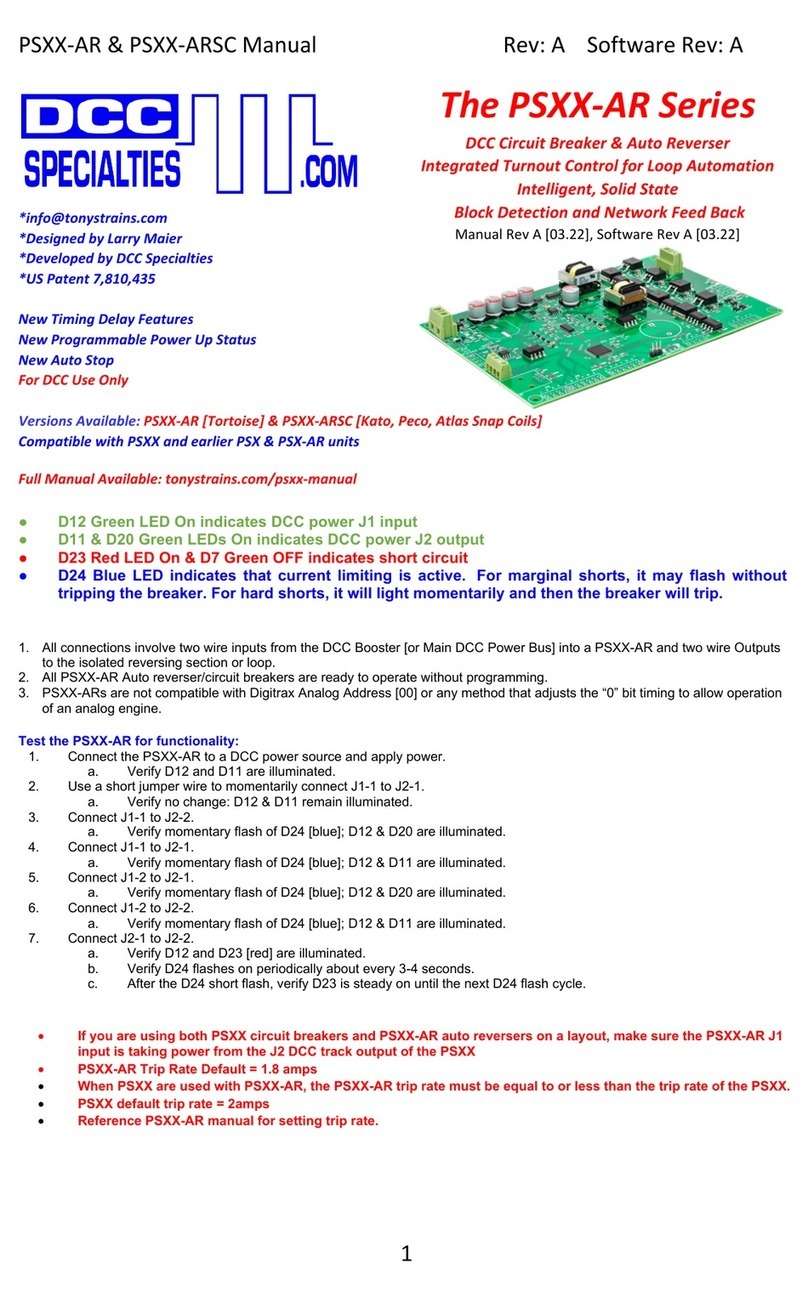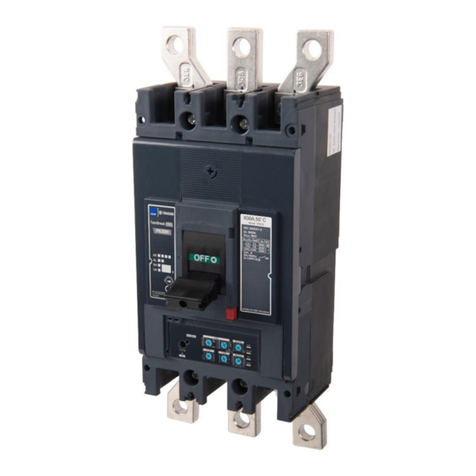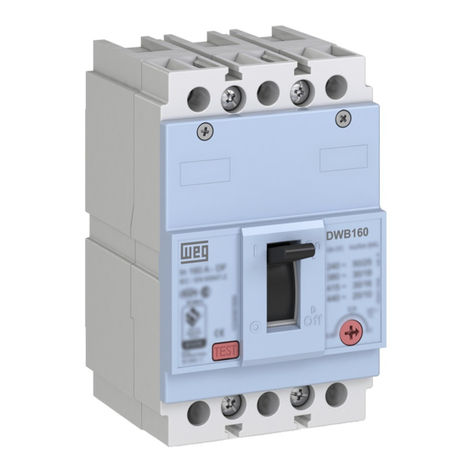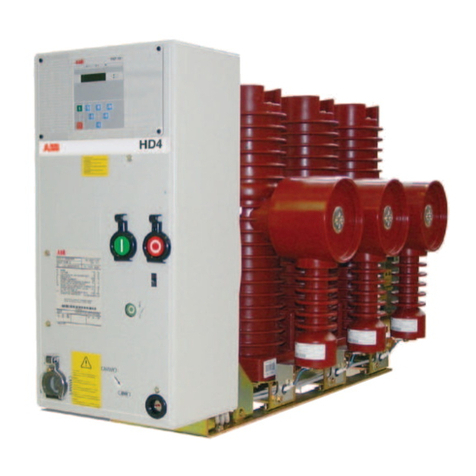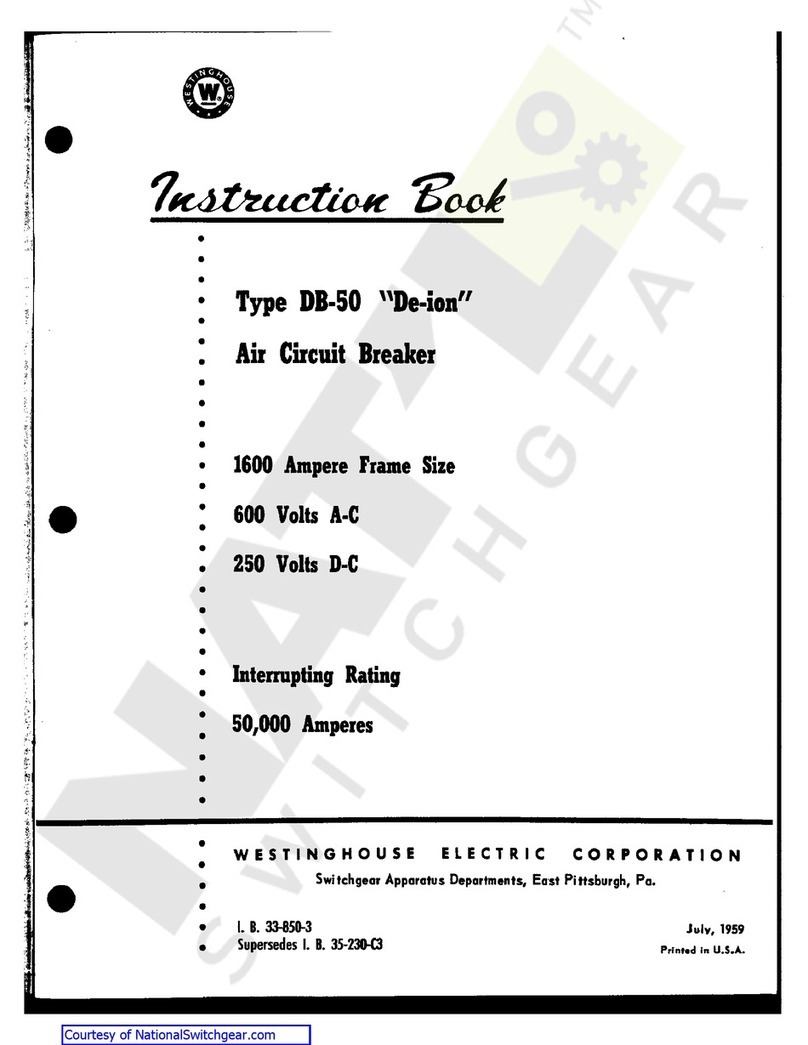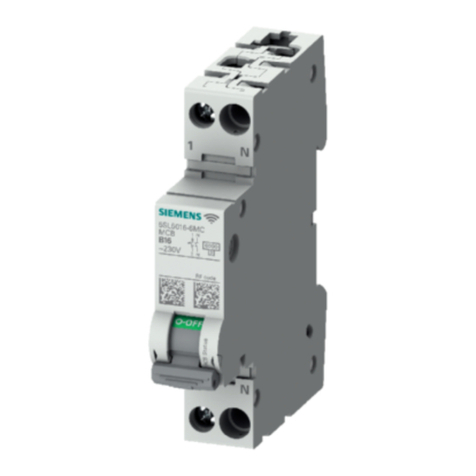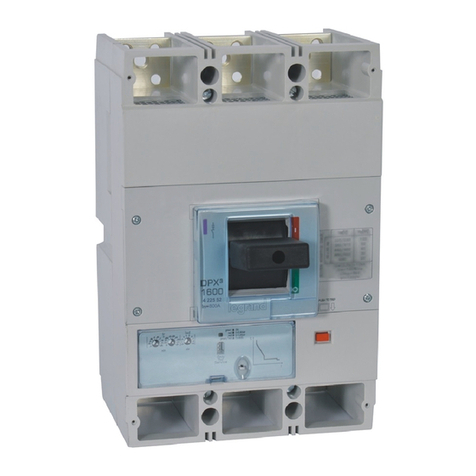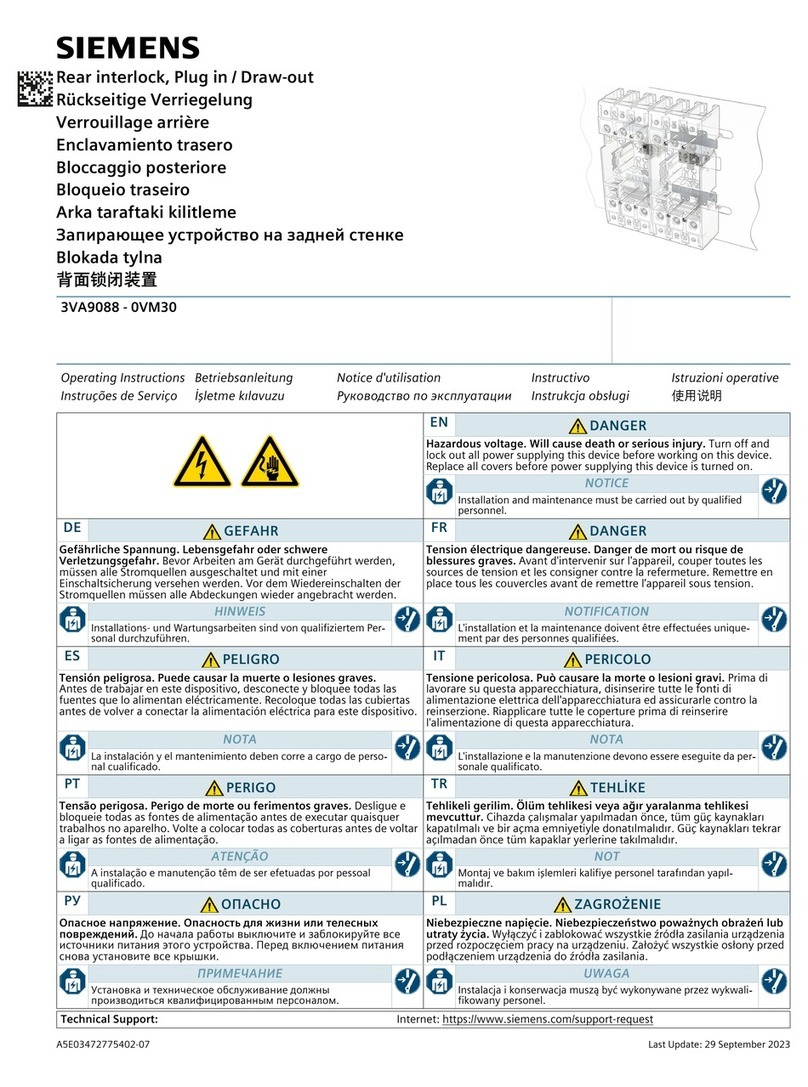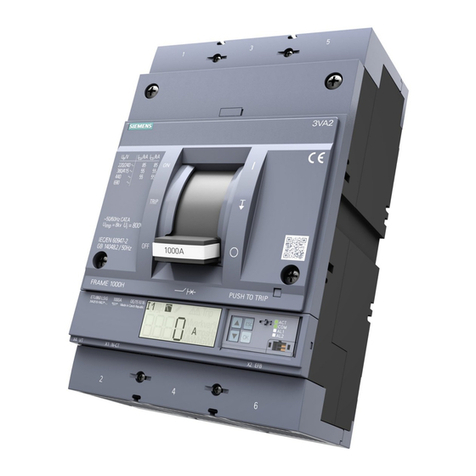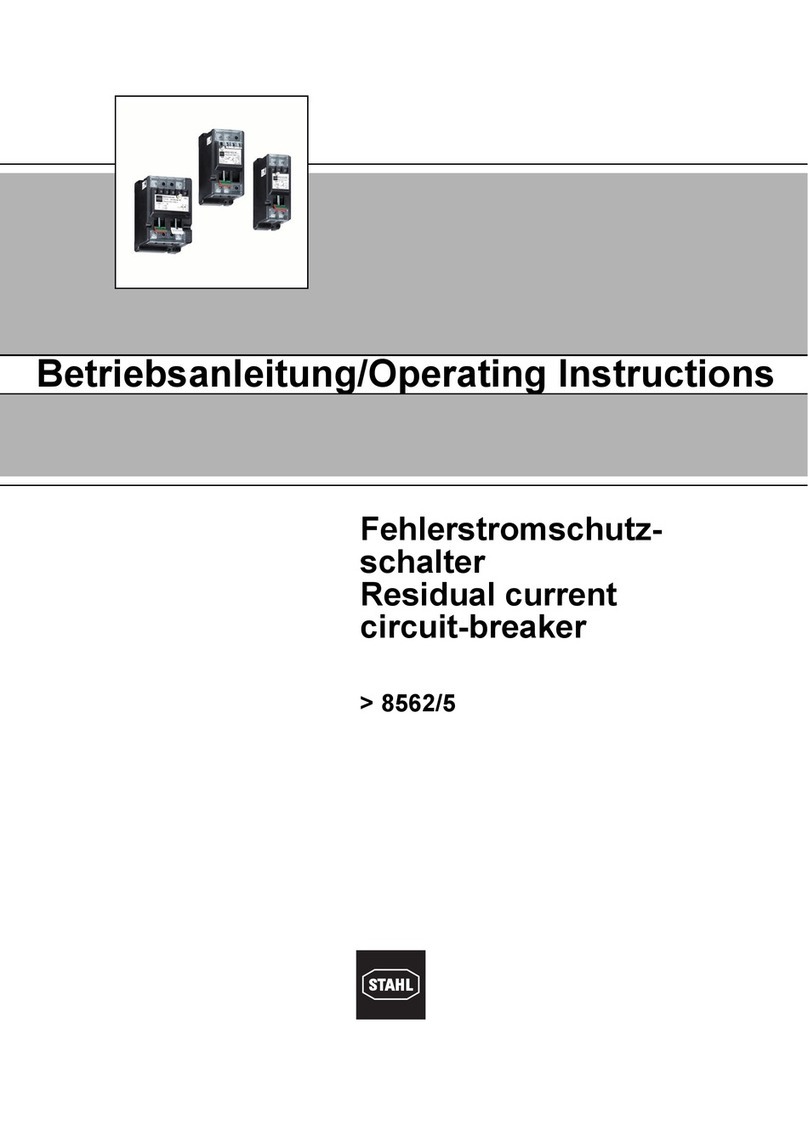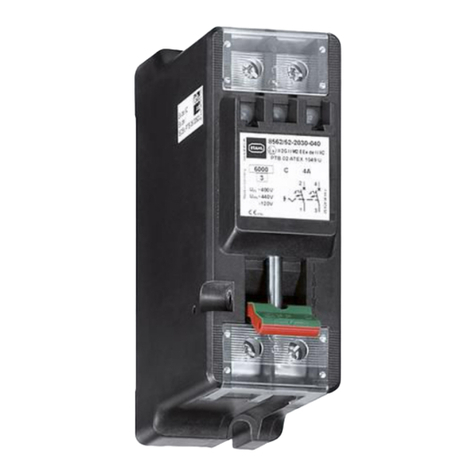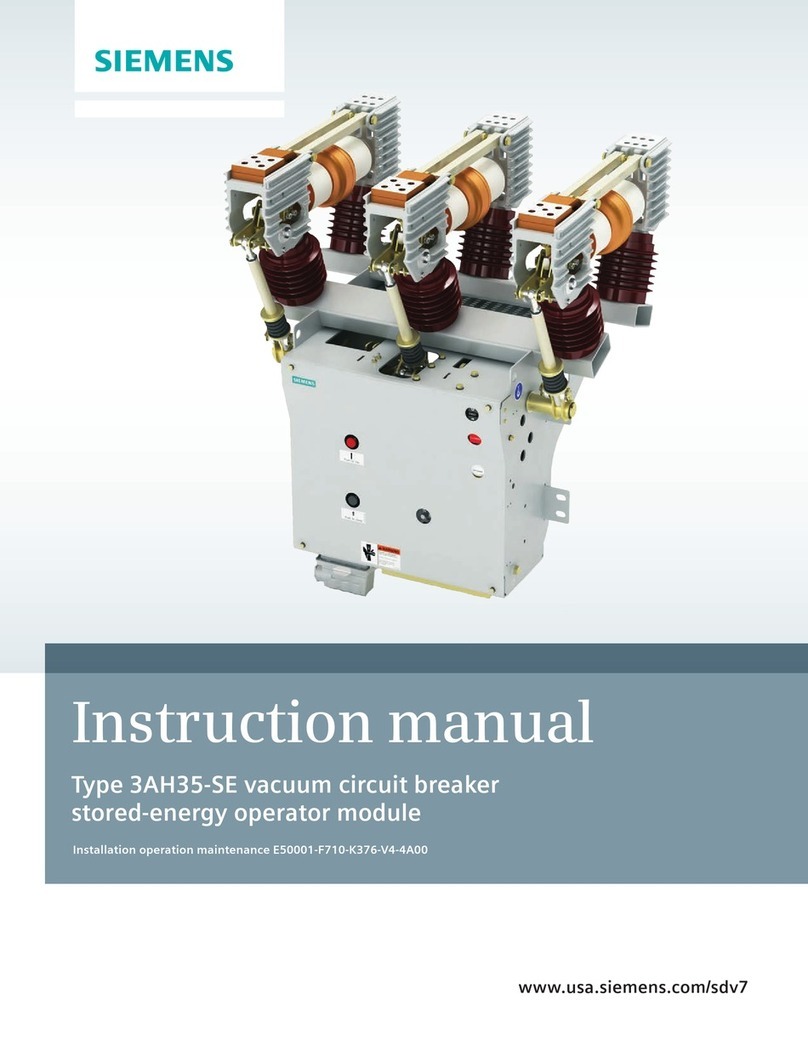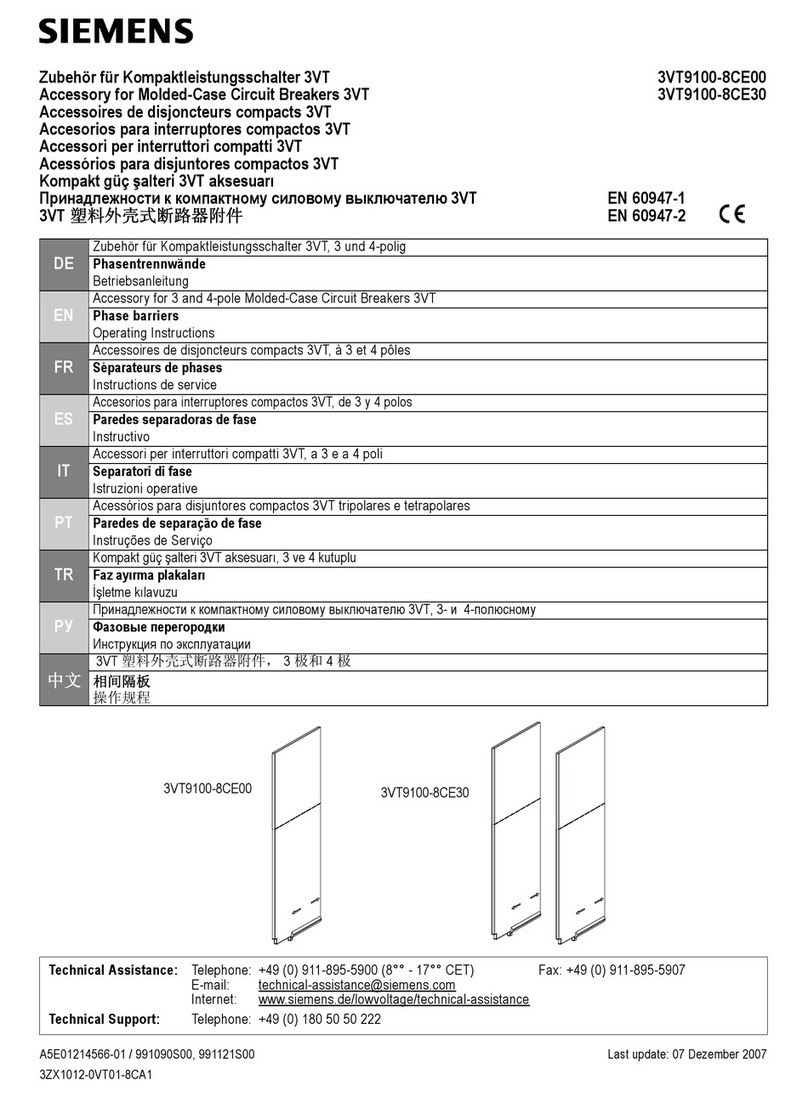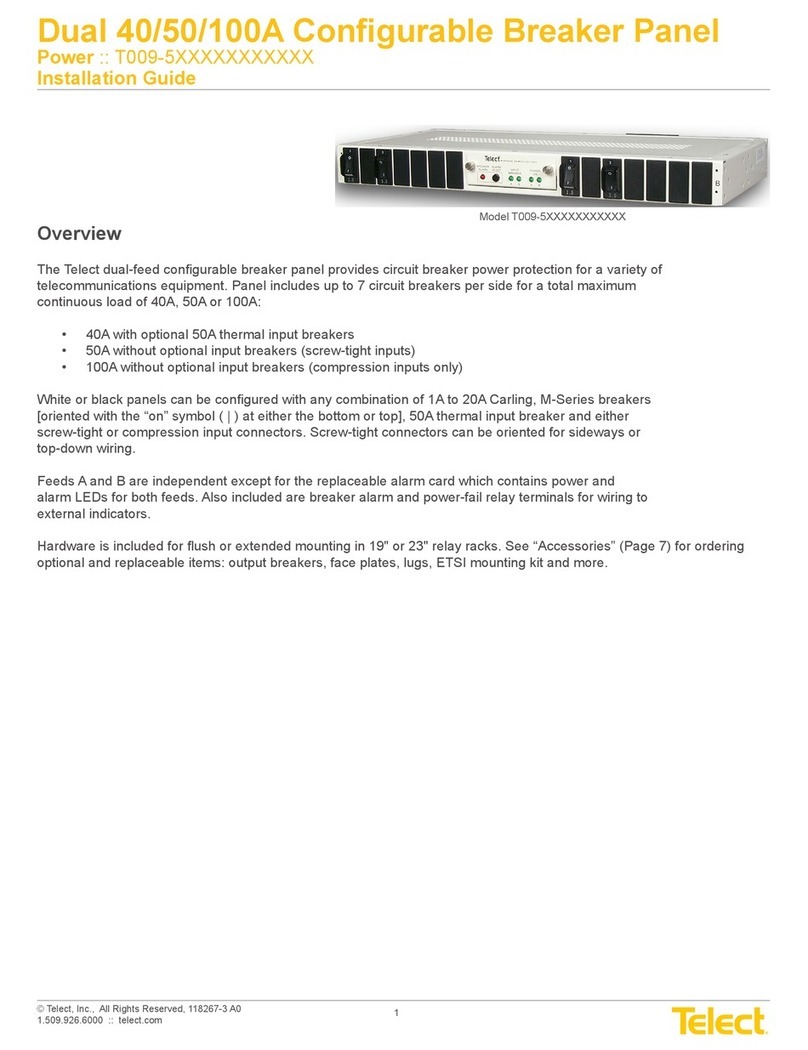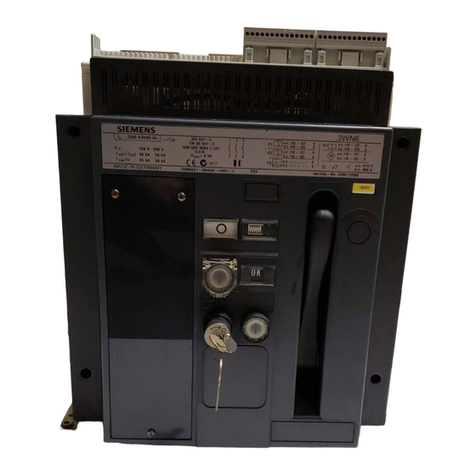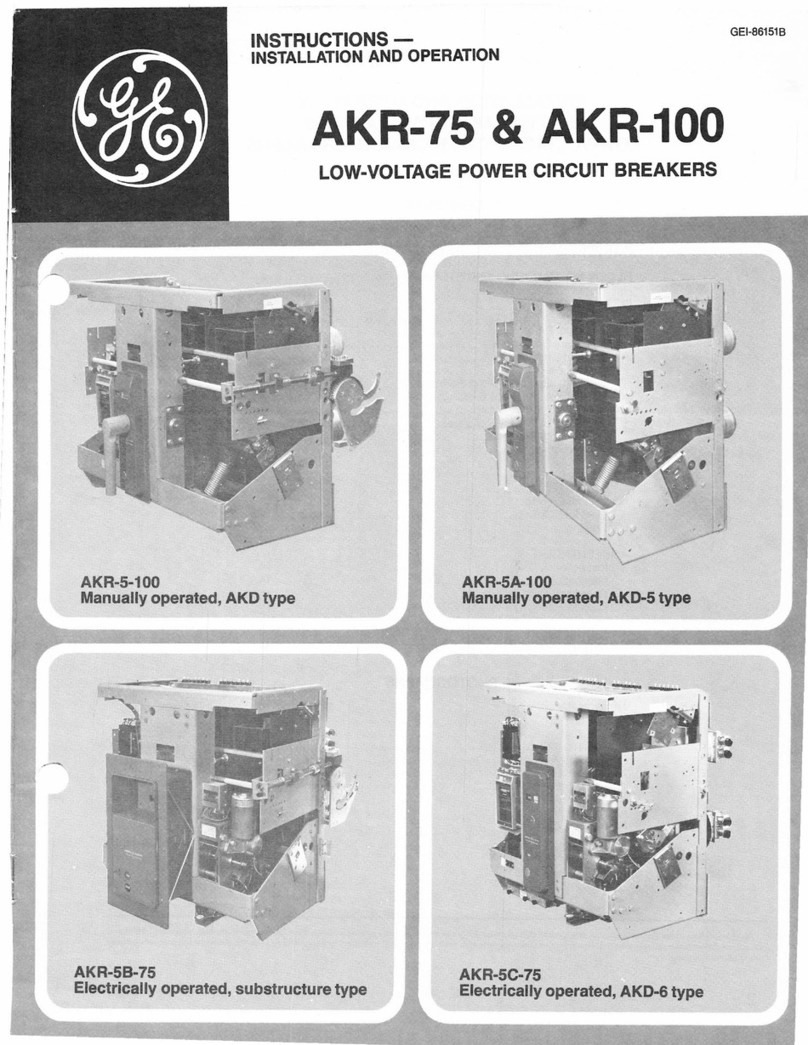DCC Specialties PS 1 Series User manual

PSXX Manual Rev: A Software Rev: F
1
*Designed by Larry Maier
*Developed by DCC Specialties
*US Patent 7,810,435
For DCC Use Only
New! Advanced Circuit Design
New! Current Limiting
New! Automatic Timing Delay
New! Block Occupied Functions
The PSXX Circuit Breaker uses a new advanced design to provide a new level of over-current
protection for your layout. Before the advent of the PSXX, all circuit breakers used a simple
low resistance switch to turn off the current if it exceeded a set value. The layout is protected,
but for the time between the onset of the short and the output switch turning off, the fault is
connected directly across the booster terminals affecting all blocks connected to the booster.
The booster will supply up to its maximum current trying to maintain the track voltage.
Currents as high as 48 amperes can result, depending on your booster and wiring. The large
current draw then means there is no current left for any other block even if they are protected
by their own circuit breakers.
The PSXX series is a product of years of research into problems dealing with false overloads
that cause premature shut down of DCC Boosters and other Circuit Breakers. These false
overloads are caused by large capacitors used in sound systems, decoders and lighted
passenger cars. The overload appears as a short circuit until the capacitors are charged. The
PSXX Series determines if the load is a true short or just an overload due to a discharged
capacitor.
PSXX Versions Available: PSXX-1, PSXX-2 & PSXX-3
●Advanced Circuit Design limits current to selected current value before circuit opens
regardless of severity of fault
●Current Limiting will charge sound decoders without exceeding booster current capability
●Default Current Limit/Trip Current 2 amperes will work correctly for most layouts.
●Select Trip current values 1 – 10 in integer steps (1, 2, 3, …., 10) using CV 49
●Jumper Select Current limits of 1, 2, 3, or 4 amperes
●PSXX circuit boards are perforated with score lines so you can physically separate and
divide PSXX-2, & PSXX-3 into individual PSXX-1 units if needed.
●Power On/Off by DCC: Turn on/off output track power with your DCC Throttle!
The PSXX-1,2,3 Series
DCC Circuit Breaker
Intelligent, Solid State
Block Detection and Network Feed Back
Manual Rev A [01.22, Software Rev F [07.22]

PSXX Manual Rev: A Software Rev: F
2
●Manual or Automatic Reset: Automatic reset: Breaker tries to reset every 2 seconds.
Manual reset: Once the breaker trips, it remains off, ensuring complete isolation of the
faulty block. The breaker is reset either by a switch or by a DCC command.
●All Solid State Operation: Fast, solid state design with reliable quiet action.
●Adaptive Load Reset: Electronically determines if the overload is a real short or due to
excess capacitance in sound decoders or lighted passenger cars.
●Auto Stop with DCC Reset: A photocell can be connected to a PSXX input. Normally,
covering the photocell will not cause any action. If the photocell is armed with a DCC
command, the PSXX will turn off the next time the photocell is covered. A DCC command
can restore the track power when desired.
●Photo Cell Controlled Block Power Off: Stop position control and occupancy detection for
hidden tracks.
●Block Detection: Either a photo cell or block current draw can be used to detect a train in
a block and to trigger a Block Occupied output. The current trigger level is
programmable.
●Block Occupied Trip point can be automatically set to compensate for current flow in
unoccupied block
●Very Low Voltage Drop: Total breaker on resistance is less than 0.060 ohms, so the PSXX
has a very low voltage drop even at high currents. Better than detectors that use a diode
voltage drop.
●Programmable Power Up Status: When power is applied to the layout, the PSXX can be
set to always turn on, always remain off [power on as needed by DCC command], or to
use the power status present when the layout was last shut down.
●Outputs for LED Indicators: Remote LEDs can be added to monitor the input/output
power and the status.
●Network Feedback: Isolated outputs designed to provide Block Occupied, Block Shorted,
and Power Status to a discrete interface for remote display or computer control. Will
work with Digitrax LocoNet, NCE Cab Bus, ESU ECoS, and Lenz XpressNet interfaces.
●System Reset: CV63=42 sets all CVs and addresses to original factory values.
●Output for Audio Alert: An audible sounder can be added to the PSXX to provide an
audible alert if there is a short.
●No Power Supply Needed: The PSXX uses the track DCC power to supply its operating
power. Each PSXX draws less than 0.04 amperes.
●Easy to Install: With 4 mounting holes sized for a #6 screw.
●Flash Programmable: The PSXX firmware can be updated by Tony’s Train Exchange as
new features become available or if older units need to be matched to a recent purchase.
●Discrete Input allows on/off control of track voltage for yard or other track section
isolation. Compatible with any system that has a relay or isolated transistor control
output including LCC, WiFi, etc. or can be used with manual toggle switch.
●4 Indicator LEDs: Booster power (green), Block power (green), Block shorted (red), Block
current limiting (blue)
●+5V and Ground Outputs for powering LEDs, no resistors needed
●Power On Status can be on, off (yard or staging sections), or status at power down.
●DCC Accessory command control on any Accessory address 1 – 2042.

PSXX Manual Rev: A Software Rev: F
3
Instruction Manual Contents
A. Quick Start
B. User Guidelines
C. How to Determine Power Districts
D. PSXX-1, 2, & 3 Wiring
E. Terminal Wiring Descriptions
F. Terminal Functions
G. PSXX Accessory Addresses
H. Programming CV’s & Values
I. CV Settings
J. Special Programming Instructions
K. DCC System Sequential Programming Instructions
A. Quick Start
1. All connections involve two wire inputs from the DCC Booster [or Main DCC Power
Bus] into a PSXX and two wire Outputs to the isolated track block
2. All PSXX circuit breakers are ready to operate without programming
3. PSXX are not compatible with Digitrax Analog Address [00] or any method that
adjusts the “0” bit timing to allow operation of an analog engine.
4. Test the PSXX for functionality:
a. Turn on DCC power to the PSXX.
b. Verify D7 LED and D12 LED are ON and D17 & D18 LED are off OFF.
c. Connect a wire from J2.1 to J2.2
d. Verify D12 is ON, D7 is OFF, and D17 is ON.

PSXX Manual Rev: A Software Rev: F
4
e. Remove the wire from J2.
f. Verify D7 and D12 return to ON and D17 turns OFF.
Programming CV’s & Values: Optional/Not Required!
The easiest way to program PSXX circuit breakers is at your work bench. Programming CV
values is done using the Programming On Main [POM] function. Refer to your DCC system
manual for specific directions on how to perform Program On Main functions.
●D12 Green LED On indicates DCC power J1 input
●D7 Green LED On indicates DCC power J2 output
●D17 Red LED On & D7 Green OFF indicates short circuit
●D18 Blue LED indicates that current limiting is active. For marginal shorts, it may
flash without tripping the breaker. For hard shorts, it will light momentarily and then
the breaker will trip.
B. User Guidelines
1. Before wiring, ensure the Programming Jumper is on pins JP1.2 & JP1.3 to operate
[Pin JP1.1 is nearest to the J7 connector]
2. Cut isolating gaps in the rails between PSXX zones, and stagger the gaps by about
0.75” [21mm]

PSXX Manual Rev: A Software Rev: F
5
If you are using both PSXX circuit breakers and PSX-AR auto reversers on a layout make
sure the PSX-AR J1 input is taking power from the J2 DCC track output of the PSXX
When PSXX are used with PSX-AR, the PSX-AR trip rate must be equal to or less than the
trip rate of the PSXX. If PSXX trip rate = 2amps, then PSX-AR trip rate must be =/less than
2amps. Reference your PSX-AR manual for setting trip rate.
3. Input and Output connectors J1 and J2 are designed to use 12 AWG-22 AWG wire.
a. Turn the screw on the connector counter-clockwise while looking at the connector
opening
b. Make sure the wire clamp is at the bottom of the connector opening.
c. Insert wire you are connecting, turn the connector screw clockwise to tighten.
2. When wiring more than one PSXX [PSXX-2, PSXX-3] insure all input/output polarities
are the same
3. If you are using a heavier bus wire such as 10 AWG, solder a short length of 12 or 14
AWG wire to your heavier bus to connect to the PSXX terminal.
4. We recommend rail drops to the track bus every 3-5 feet. Insufficient feeders can cause
your track voltage to be significantly lower than your booster output voltage.
5. The PSXX Circuit breaker is designed to operate by opening one side of the two input
leads when an overload is detected.
a. J1-1 and J1-3 are connected to J2-1 by a copper trace.
a. Any application where a common rail is used should connect the common rail to
these terminals.
b. The connection from J1-2 and J1-4 to J2-2 is opened when the breaker trips or
is turned off.
1. Connect the two wires from the DCC Booster to the PSXX J1-1 & J1-2 INPUT terminal
2. When Power is applied to the PSXX, the D12 LED near the J1 Input and the D7 LED
near the J2 Output should be on.

PSXX Manual Rev: A Software Rev: F
6
1. If the D17 LED near the JP1 Programming Jumper is on solid, you may have a short
between the two wires from the J2 Output or in the track section.
1. Test the PSXX installation prior to running a train:
a. Observe your DCC booster is not shorted.
b. Use a suitable metal object to short the track.
c. The status LED D17 should come on and D7 near the output should be off.
d. Your booster should not trip during this test [D12 stays on].
2. If your booster does trip during this test [D12 goes off or flashes on and off], it may not
be able to support automatic reset.
a. Install the Manual Reset jumper [J7-1 to J7-2] and repeat the test. Your booster
should now remain on [D12 stays lit].
b. With the Manual Reset jumper in place, you can reset the PSXX by sending an
accessory ON command [check your system manual for correct key sequence] to
accessory address 2042. Refer to CV68 for address limitations.
c. With the Manual Reset jumper in place, you can also reset the PSXX by connecting
a Normally Closed push button in series with the Manual Reset jumper. Pressing
the button will reset the PSXX.
C. How to Determine Power Districts
If you are using both PSXX circuit breakers and PSX-AR auto reversers on a layout make
sure the PSX-AR J1 input is taking power from the J2 DCC track output of the PSXX
When PSXX are used with PSX-AR, the PSX-AR trip rate must be equal to or less than the
trip rate of the PSXX. If PSXX trip rate = 2amps, then PSX-AR trip rate must be =/less than
2amps. Reference your PSX-AR manual for setting trip rate.
There are two types of power districts: Single power district per booster or multiple power
districts on a single booster. In either case, you want a PSXX protecting each power

PSXX Manual Rev: A Software Rev: F
7
district. If you have a single booster for a power district, you still want a PSXX-1 protecting
that district. The reason is that the protective circuitry in the booster is designed to protect
the booster, NOT your $1000 fully lit, full sound, decoder equipped, fully detailed scale
model. The PSXX series IS designed to protect your models. For the multiple power
district per booster, you want to use a PSXX-2 or PSXX-3, . Each PSXX feeds a district,
and the inputs of the PSXX are daisy chained together to a single booster.
Probably the best way to determine where to place power districts is to take a look at the
expected current draw [primarily locomotive motors which use power] for each operating
location on the layout. For example, a busy yard might have several switchers, one or
more trains on the arrival and departure tracks, another train or two passing the yard on
the main, and maybe a peddler local working nearby industries. If some or all of these
trains have more than one locomotive, you could have 10 to 15 current drawing units all
competing for power in a fairly small area. Assuming all the locomotives have efficient
motors, this type of power requirement [amps] may be large enough to overload a DCC
system powered from one 5 Amp booster. For example, if you have four PSXX set to the
default current, each PSXX will trip at 2 amperes. If each power district draws 2 amperes,
that is a total of 8 amperes. None of the PSXX will trip, but your 5 amp booster will certainly
shut down. You can solve this by lowering the trip current on each of the four PSXX,
getting a booster with a higher current rating, or splitting the four districts on one booster
to two districts on each of two boosters.
If you are using both PSXX circuit breakers and PSX-AR auto reversers on a layout make sure
the PSX-AR J1 input is taking power from the J2 DCC track output of the PSXX
When PSXX are used with PSX-AR, the PSX-AR trip rate must be equal to or less than the
trip rate of the PSXX. If PSXX trip rate = 2amps, then PSX-AR trip rate must be =/less than
2amps. Reference your PSX-AR manual for setting trip rate.

PSXX Manual Rev: A Software Rev: F
8
Based on our experience, a typical HO scale 5 Amp system can support up to 10 operators
using a 12-14 AWG bus and 20 AWG feeders. Many users overestimate the amount of
Booster power needed. Try using the PSXX Series first. If your DCC Booster overloads
from excess current draw, you need to add an extra DCC Booster to support the
concentration of trains in this location. By dividing a layout into power districts in this
manner, and using a combination of boosters and circuit breakers, you can make the most
efficient use of available power on any mid-size or large-size layout.
Another thing you want to keep in mind while designing power districts is how each district
is used. In a yard area, for example, there is a higher risk of derailments occurring with
their associated shorts. You might want to isolate this area into a separate district so that
a short in the yard will not stop mainline operations.
D. PSXX-1, 2, 3 Wiring
Wire to the PSXX should be heavy enough to carry the current efficiently. The size of
wire depends on your scale. Too much resistance in the wire or rails can result in
faulty short sensing, voltage drop and poor performance. At a minimum, we
recommend the following stranded gauge wires to prevent potential problems:
●N Scale 18 AWG bus, 22 AWG rail feeders
●HO Scale 14 AWG bus, 18 AWG rail feeders
●O Scale 12 AWG bus, 16 AWG rail feeders
We recommend using stranded pair wire such as speaker or lamp cord wire for bus
wiring. If you’re using two individual stranded wires, make sure to twist the wire 4 to 6

PSXX Manual Rev: A Software Rev: F
9
times every foot. You can make your own twisted pair wire by placing two ends of the
wire in a drill bit, chuck the drill tight, and then turn on while you or something else
holds the other end
***PSXX LED Outputs do not require resistors***
E. Terminal Wiring Descriptions
J1 Input Power Connector
●J1-1 DCC Power Input 1 [from DCC Booster]
●J1-2 DCC Power Input 2 [from DCC Booster]
●J1-3 Connect to next PSXX J1-1 [Power Link]
●J1-4 Connect to next PSXX J1-2 [Power Link]
J2 Output Power Connector
●J2-1 Switched DCC Power Output 1 [to track/bus]
●J2-2 DCC Power Output 2 [to track/bus]
JP1 Program Jumper
●JP1-1 & JP1-2 Place jumper on pins 1 & 2 for Programming
●JP1-2 & JP1-3 Place jumper on pins 2 & 3 for Operations
J4 Block Occupancy
●J4-1 Input Manual OFF +
●J4-2 GND Manual OFF -
●J4-3 Output Block Shorted Emitter
●J4-4 Output Block Shorted Collector
●J4-5 Output Block Occupied Emitter
●J4-6 Output Block Occupied Collector
J5 Status Outputs [Remote]
●J5-1 +Remote D17 (RED) Anode
●J5-2 - Remote D17 (RED) Cathode
●J5-3 + Input Photocell
●J5-4 - GND Photocell
J6 Trip Current Settings by Jumpers
●Set trip current using either Jumpers or CV 49: NOT BOTH
●No Jumpers = 2.0 amperes [default]
●J6-1 to J6-2 = 1.0 amperes
●J6-3 to J6-4 = 3.0 amperes
●If both jumpers are installed [J61-J62 & J63-J64], the current limit is set to 4.0 amperes.
***PSXX LED Outputs do not require resistors***

PSXX Manual Rev: A Software Rev: F
10
PSXX LED Outputs do not require resistors
J7 Auto/Manual Reset & Powering LEDs
●J7-1 +5V Output for powering external LEDs, etc. in conjunction with Block Occupied
or Block Shorted outputs. Maximum load should be less than 25mA.
●J7-2 GND Return connection for J7-1 5V output
●J7-3 to J7-4 with Jumper: Manual Reset [open to reset] The user can install a
normally closed switch in series with the jumper. Open the switch to reset the PSXX or
send an accessory ON command to the PSXX on-off command address [see Section B
item 11]
●J7-5 TBD
●J7-6 GND
J10 DCC Power In Remote LED Indicator Output
●J10-1 +Remote D12 (Green) Anode
●J10-1 - Remote D12 (RED) Cathode
J11 Track Power On Remote LED Indicator Output
●J11-1 +Remote D7 (Green) Anode
●J11-2 - Remote D7 (RED) Cathode
F. Terminal Functions
J1 – DCC power input connections from the DCC booster. The J1 can be branched out
to allow multiple connections to other PSXX breakers and PSX-AR reversers. The
Power Link [J1-1 & J1-2] makes it easier to connect to another PSXX circuit breaker or
PSX-AR auto reverser.

PSXX Manual Rev: A Software Rev: F
11
J2 – DCC track power output terminal from the PSXX circuit breaker to the track.
JP1 – Programming & Operation jumper. Normal operating configuration is when the
jumper is in the JP1-2 to JP1-3 position. Place the jumper in the JP1-1 to JP1-2 position
to enter programming mode.
J4-1 and J4-2 are the inputs for the photocell detector used for the stopping function
and/or the block occupancy function. Note:
●Be sure there is sufficient light above the cell to trigger the circuit.
●You can use a white LED to illuminate the photocell.
●Whenever you arm the photocell, it assumes it is uncovered and adjusts its
sensitivity to the current lighting conditions.
●It is sensitive across the light spectrum. White will be best.
●The photocell sensitivity is calibrated to the local light intensity each time the
photocell is armed.
●You can order the photocell sensor through Tony’s Train Exchange.
J4-3 [-] and J4-4 [+]are connected together [up to 5 mA] when the breaker has detected
a short circuit and open during normal operation. This is an optically isolated open
collector transistor and provides no power.
J4-5 [-] and J4-6 [+] are open if the block is not occupied and are connected together
[up to 5 mA] if the block is occupied. This is an optically isolated open collector transistor
and provides no power.
J5-1 [+] and J5-2 [-] are for a remote status LED. The LED is connected directly to the
terminals. J5-1 and J5-2 have resistors installed on the board that limit the current to
about 5mA (780 ohms)No resistor is required. The remote LED will duplicate the state
of D6.
J5-3 [+] and J5-4 [-] are for network power status reporting. They are connected
together [up to 5 mA] when the PSXX output switch is ON. This is an optically isolated
open collector transistor and provides no power.
J6 – Sets the current trip level. When CV49=00 [default] the trip current is 2.0 amperes
if no jumpers are installed. This is the correct setting for the NCE Power Cab. If J6-2 is
connected to J6-1 and J6-4 to J6-3 is open, then the current trip is 1.0 amperes. If J6-4
is connected to J6-3 and J6-2 to J6-1 is open, then the current trip is 3.0 amperes. If J6-
4 is connected to J6-3 and J6-2 is connected to J6-1, then the current trip is 4.0 amperes.
J7-1 and J7-2 are available for powering external LEDs, etc in conjunction with Block
Occupied or Block Shorted outputs. Maximum load should be less than 25mA. J7-1 is
the 5v output and J7-2 is the GND Return connection for the J7-1 5V output
J7-4 to J7-3 are the auto/manual reset inputs. If the connections are open, the breaker
will automatically try to reset every two seconds [default]. If the terminals are connected
together with a SPST toggle switch or N/C push button switch, then the breaker will
remain off after a short until the connection from J7-1 to J7-2 is momentarily opened or
an accessory ON command is sent to the PSXX on-off accessory address [see Section
B item 13].

PSXX Manual Rev: A Software Rev: F
12
J7-5 & J7-6 Output TBD
J8 Used to program software updates. Do not make any connections
J10-1 [+] and J10-2 [-] output is on any time that D12 (GREEN) is on. This output should
ONLY be connected to an isolated LED. Use an optical coupler interface for all other
uses.
J11-1 [+] and J1 1-2 [-] output is on any time that D7 (GREEN) is on. This output should
ONLY be connected to an isolated LED. Use an optical coupler interface for all other
uses.
G. PSXX Accessory Addresses
See Section K: DCC System Sequential Programming Instructions for Setting
Address and Programming CV’s
The easiest way to address a PSXX circuit breaker is at your workbench. The
PSXX’s addresses are SET by moving the program jumper as described below
and issuing an accessory command like operating an accessory by using your
DCC Throttle.
For all systems, whenever you enter an address or CV value, you should see D17 flash. This indicates
the PSXX has received the information, stored it, and verified the stored data match the data you sent.
There are three [3] accessory addresses used by the PSXX. The third address is
reserved for future functions.

PSXX Manual Rev: A Software Rev: F
13
G.1 Setting the Three Accessory Addresses:
1. Turn off power to the PSXX
2. Place the JP1 programming jumper on pins JP1-1 & JP1-2
3. Connect the DCC track power output of your DCC system to pins J1-1 and J1-2.
4. Turn power on to the PSXX.
5. The next accessory command issued by the DCC system will be stored as the first
address [track on/off].
6. Key in the first address you want to use and press either the ON or OFF accessory
command [or the appropriate key for your throttle – see the chart below]
7. By default, the PSXX will store the next two sequential addresses as the second
and third PSXX address.
8. If you don’t want to use these values, then key in an address that you want to use
for the second address and issue an ON or OFF command.
9. Repeat for the third address you want to use.
10.Each time you press the ON or OFF key with a new address, you should see D17
flash indicating that the PSXX received the address and stored it.
11.Once you are happy with the addresses that you want to use, turn off the DCC
power to the PSXX.
12.Put the program jumper back to JP1-2 and JP1-3 unless you are going to program
CV settings.
13.Note the default addresses are 2042, 2043, and 2044. Refer to CV68 for address
limitations.
Reference Chart for the Two Accessory Commands
Function Default Address New Address
Arm Photocell
2043 [998]
?
Track Power On/Off
2042 [997]
?
System
Normal [Clear]
Thrown
Digitrax
c or Closed
t or Thrown
ESU
Special Instructions
Special Instructions
MRC
ON
OFF
NCE
Normal/ON/ 1
Reverse/OFF/ 2
The Table above shows how the DCC Manufactures identify the Normal [Clear] and/or the
Thrown Route to operate accessories.

PSXX Manual Rev: A Software Rev: F
14
G.2 Using Accessory Addresses:
1. The first PSXX accessory address [Default address 2042, 997 for Digitrax] lets you
use DCC Accessory Commands to turn the PSXX DCC output on and off.
2. The second PSXX accessory address [Default address 2043, 998 for Digitrax] is used
to arm the photocell circuit.
a. If the photocell is not armed [power on condition] then covering or uncovering the
photocell has no effect.
b. Sending an ON accessory command to the second address [default 2043, 998
for Digitrax] arms the photocell.
c. When armed, the ambient light level at the photocell is measured.
d. If the ambient light level drops significantly [e.g. a train covers the photocell], the
output of the PSXX is turned off removing power from the track.
e. Once the output has turned off, the photocell reverts to being unarmed until the
next arming command.
f. Track power can be restored by issuing an accessory ON command to the first
PSXX accessory address.
g. This is designed to allow you to stop a train at a known point on a hidden staging
track. As the train enters the staging [or other] track, you issue the photocell
arming command. When the train just covers the photocell, the PSXX will turn off
and the train will stop exactly at the photocell.
h. In order to leave the staging area, simply issue an accessory ON command to the
first PSXX accessory address. The PSXX will apply power to the track and the
train can be moved. Since the photocell is now disarmed, you can move the train
over the cell without affecting the power status.
For all systems, whenever you enter an address or CV value, you should see D17 flash. This indicates
the PSXX has received the information, stored it, and verified the stored data matches the data you sent.
3. Advanced staging control The photocell can act as a block occupied detector and a
staging control at the same time.
a. Connect a photocell between J4-1 and J4-2.
b. Connect the cathode [-] of an LED to J4-2 and the anode [+] to J4-4.
c. Install a wire between J4-3 and J6-2
d. Set CV50=1 and CV66=0.
e. This will set the photocell to also control the block detector output [which has the
LED connected now] and will have the PSXX power up with the output OFF so
staging areas don’t normally draw current.
f. When you arm the photocell with these settings, the LED will slowly flash
indicating it is waiting for a train.
g. When a train enters the block and covers the photocell, the track power will turn
off and the LED will change from flashing to steady indicating that a train is now
in the block.
h. Further, the PSXX has stored the last photocell calibration values, so you can
shut down the layout with a train in the staging, and the PSXX will remember to
show block occupied the next time you power on.
i. As in the basic photocell control, simply send an accessory ON command to the
first PSXX accessory address and the block power will turn on. The occupied LED
will remain on until the end of the train clears the photocell while the train is
leaving the block.

PSXX Manual Rev: A Software Rev: F
15
H. Programming CV’s & Values: Optional/Not Required!
Specific DCC Systems need to follow specific programming sequences to reliably
program a PSXX circuit breaker. See Section K for specific system instruction
The easiest way to program PSXX circuit breakers is at your work bench. Programming CV values
is done using the Programming On Main [POM] function. Refer to your DCC system manual for
specific directions on how to perform Program On Main functions.
For all systems, whenever you enter an address or CV value, you should see D17 flash. This indicates
the PSXX has received the information, stored it, and verified the stored data matches the data you sent.
1. Turn off power to the PSXX
2. Place the JP1 programming jumper on pins JP1-1 & JP1-2
3. Connect the DCC track power output of your DCC system to pins J1-1 and J1-2.
4. Turn power on to the PSXX.
5. Go into Program On Main mode [POM] for your particular DCC system.
6. Enter any address NOT in use on the layout. The PSXX does NOT use this
address, but the POM function requires an address.
7. Enter the CV number followed by the value. The small red LED [D17] on the
PSXX will blink each time a command is accepted and the CV value is stored
correctly in the CV.
8. If you make a mistake, don’t worry, just go back and program the CV to the
desired value.
9. If you are hopelessly lost, set CV63 to 42 and you can start over again with
factory default values.
10.When done, turn power off
11.Replace the program JP1 jumper to pins 2-3.
12.Turn power on to the PSXX.
I. CV Settings
CV49 Current Limit/Trip Current value
●Default value=2
●If CV49=0, then the Current Limit/Trip Current jumpers on J6 are enabled.
Remember to use either the Jumpers or the CV settings, NOT BOTH!
●Setting CV49 to a value from 1-10 will set the trip rate matching the value.
●For example:
CV49=1 Trip Rate = 1.0 amperes
CV49=2 Trip Rate = 2.0 amperes [default]
CV49=3 Trip Rate = 3.0 amperes
CV49=4 Trip Rate = 4.0 amperes
CV49=5 Trip Rate = 5.0 amperes
CV49=6 Trip Rate = 6.0 amperes
*Caution: continuous operations at a value of CV49=10, [10.0 amps] without the addition of heat sinks to the
output transistors may overheat or damage the PSXX. Heat sinks are available from DCC Specialties. PSXX’s can
also be ordered with heat sinks installed by DCC Specialties.

PSXX Manual Rev: A Software Rev: F
16
Low Current System Trip Current Settings:
●For the Digitrax Zephyr [DCS50, DCS51, DCS52], setting values of CV49=01,
02, & 03 is OK.
●The NCE Power Cab should use the default value of CV49=02.
●For the PowerCab cv49=1 is ok too.
●Most 5 amp boosters should be happy with CV49 = 0-5
CV50 Block Occupied Detection Method
●Default = 0.
●CV50=0 - Block Current controls Block Occupied output.
●CV50=1 - Photocell controls Block Occupied output.
●Block current is used to indicate the block is occupied and the train is
somewhere within the block.
●Photo cell is used to indicate the train is at a specific point in the block
CV52 Enable Discrete Control of DCC2 output
●Default = 0, input is disabled
●CV52=66 enables discrete on/off control of DCC2 output using J4-1 and J4-2
inputs.
●Any other value disables the J4-1 and J4-2 inputs.
●When enabled, a connection from J4-1 to J4-2 turns DCC2 off.
●DCC1 is the connection from J1-1 to J2-1. It is a copper trace. DCC2 is the
connection from J1-2 to J2-2 and goes through the solid state switch which
allows this connection to be open or closed (OFF or ON).
CV53 Enable Block Current Auto-Calibration
●Default = 0, no calibration.
●CV53=66 enables Block Current Auto-Calibration the next time the PSXX is
turned on.
●CV53 is set to 66, power is removed, and JP1 is returned to the 2-3 position.
●When the PSXX is next turned on, it will measure the average Block Current
and store the value in CV56.
●This will prevent the Block Occupied output from turning on due to any
background current (such as from lights, switch motors, etc.) in the block
●The Block Occupied will turn on if the current in the block increases above the
background value due to block occupancy
●The PSXX automatically returns the value to 0 after the block is calibrated.
CV54 Block Current Off Hysteresis sets the current level at which the PSXX turns
on the Block Occupied output. This allows you to set a level above the leakage
current on the track to prevent false indications.
●Default = 5
●The Block Occupied output will be OFF if the detected current is less than the
sum of CV56 and CV54.
●In general, this value should only be adjusted if the Block Occupied output will
not turn off and you have done an Auto Calibration (see CV53).

PSXX Manual Rev: A Software Rev: F
17
CV55 Block Current Trip Hysteresis
●Default = 4.
●The Block Occupied output will turn ON when the detected current is more than
the sum of CV54, CV55 and CV56.
●In general, this value should not be adjusted unless the Block Occupied output is
chattering on and off.
CV56 Average Unoccupied Block Current
●Default = 27, acceptable values 1 - 255.
●The average value of the current in the block that is just below the trip level.
●The value may be set manually as required
●Note: the current input uses a nonlinear function, so manual setting is by trial and
error) or automatically using CV53.
●Any current above this value may cause the Block Occupied output to turn ON.
●When set automatically, a resistance of 3.3K will add enough current above the
background to turn the Block Occupied output on.
●Increasing the value will increase the current required in the block to turn the
Block Occupied output on.
CV63 initiates a PSXX Factory Reset.
●Using the Program On Main programming mode of your DCC system, set CV63=42.
●You will see D6 flash.
●After D6 flashes, all CVs and addresses are returned to their original factory
values.
●The CV63 default is 0. Setting CV63=42 will not change the CV value, but it will
reset the PSXX.
CV66 controls how the PSXX outputs power to the track when the associated booster is
turned on.
●Default=1
●CV66=0 The PSXX J2 output will always be OFF after the booster powers up. This
is useful for staging and storage yards or similar layout sections where there is no
point in using booster power for equipment that will not be running. When needed,
the PSXX is turned ON by an Accessory Command.
oIf a photocell is connected and CV50=0, then the photocell will always be
calibrated and disarmed. It will only control power output.
oIf a photocell is connected and CV50=1, the photocell is enabled to control both
the PSXX power output and the PSXX Block Occupied output. With this option,
the photocell remembers its calibration at booster shutdown so that the next
power on session it will correctly identify if the block is occupied [photocell
covered] or not [photocell uncovered]. The photocell is NOT calibrated and is
disarmed
oIf CV50=1, Block Occupied will flash when the photocell is armed. It will become
steady [on without flashing] when the photocell is covered and the PSXX output
is switched OFF [stopping train over photocell; Block Occupied indicating
OCCUPIED].
●CV66=1 The PSXX output will always be ON after the booster powers up.

PSXX Manual Rev: A Software Rev: F
18
oIf a photocell is connected, it will always be calibrated and disarmed regardless
of the value in CV50
●CV66=2 The PSXX output will assume the same state it was in when the connected
booster was last turned off.
oIf the stored power down state is OFF, the PSXX will behave the same as if
CV66=0
oIf the stored power down state is ON, the PSXX will behave the same as if
CV66=1
●CV66 default is 1. The PSXX will always power up and the photocell [if present] will
always calibrate and be disarmed.
●In the event that the photocell is calibrated while covered, it will mis-calibrate [it
assumes it is uncovered]. In most cases, simply waiting until the next time the
photocell is armed will solve the problem since it will perform a calibration before
arming. If you want to calibrate the photocell but NOT arm it, send an accessory
OFF command to the second PSXX address. Make sure the photocell is uncovered
when you issue the command. This is useful if you are using the photocell for block
occupancy detection.
CV67 is used to inhibit flashing of the Block Occupied output when the photocell is armed.
●If CV50=1 and CV66=0, the Block Occupied output will flash whenever the
photocell is armed. The PSXX power output is on.
●The flashing can be inhibited by setting CV67=1. Any other value of CV67 will
enable the flashing.
●CV67 default is 0 [flashing enabled].
CV68 blocks Accessory Addresses 1017 to 1020 from being used when CV68=0.
●This prevents some Digitrax systems from incorrectly programming the PSXX
addresses.
●Setting CV68=1 enables these addresses. Default=0
J. Special Programming Instructions
Specific DCC Systems need to follow specific programming sequences to reliably
program a PSXX. See Section K for specific system instruction
All systems: Program CV’s using POM. Do not use Program track or accessory
programming.
If the PSXX is reset [CV63=42], the default address will be 2042, 2043 & 2044. These
addresses are not accessible to Digitrax LocoNet equipment.
For all systems, whenever you enter an address or CV value, you should see D6 flash. This indicates the
PSXX has received the information, stored it, and verified the stored data matches the data you sent.
Lenz:
The Lenz system sends repeat accessory commands as long as you hold down the 1 or
4 command key. This ensures that the accessory decoder sees the message, but can
result in the same address stored multiple times while programming a PSXX. The solution
is simple:
1. Hold the 1 or 4 key down for only a short time.

PSXX Manual Rev: A Software Rev: F
19
2. Release the control key Once you see the PSXX’s D10 LED flash indicating an
address has been stored.
3. If you see multiple flashes, you have stored the same address more than once.
4. Since the PSXX will flash D10 each time you send it an accessory address, you
can easily get a feel for the timing involved.
5. In normal operating mode [not programming mode], select an accessory address
that has not been programmed into the PSXX.
6. Send an accessory command to this address and hold down the 1 or 4 control
key.
7. D10 will flash each time the command station repeats the accessory address.
This will give you a feel of how long to hold the control key while you are
programming to avoid storing multiple addresses.

PSXX Manual Rev: A Software Rev: F
20
K. DCC System Sequential Programming Instructions for Setting
Address and Programming CV’s
For all systems, whenever you enter an address or CV value, you should see D6 flash. This indicates the
PSXX has received the information, stored it, and verified the stored data matches the data you sent.
Digitrax Using the DT400/402/500 Setting PSXX Addresses:
1. Disconnect PSXX from DCC power
2. Move PSXX Jumper to Program Position Pins 1 & 2
3. Turn DCC power on “PWR”+ “ Y+”
4. After 30 seconds, reconnect DCC power
5. Press “SWCH” key to enter Switch Mode
6. Select the switch number to be set using the keypad or RH knob.
7. Press either the “OPTN” or “CLOC” key to set address.
8. Repeat steps 6 and 7 until all addresses set.
9. Press “EXIT” key to return to LOCO mode.
10. Turn DCC power off “PWR” “ N –“.
11. Move PSXX JP1 Jumper to Run Position
12. Turn track power on.
13. Test the switch address setting by using the “SWCH” key and switch addresses.
Digitrax Programming PSXX CVs: Using DT400/402/500 Do Setting Addresses First
1. Disconnect PSXX from DCC power.
2. Move PSXX JP1 Jumper to Program Position Pins 1 & 2
3. Turn DCC power on “PWR” “ Y+”
4. After 30 seconds, connect DCC power to the PSXX
5. Select an unused locomotive number with the keypad or RH knob.
6. Press “PROG “ key until you get from Pg to Po
7. Use LH throttle dial to set the CV # and the RH throttle for the CV value.
8. Press ENTER
9. Repeat steps 7 & 8 until all the CV values are set.
10. Press EXIT
11. Turn DCC power off “PWR” “ N –“.
12. Move PSXX JP1 Jumper to Run Position
13. Turn track power on.
Audible Short Indication The two holes inside the circle [U8] on the top of the board are for use
with an audible short indicating device. It is designed for use with part no. compsonalert. The device
is installed with the [+] terminal in the square hole.
You can obtain these components for all PSXX devices from
Tony’s Train Exchange: 800.978.3472 info@tonystrains.com
Part no. compsonalert Part no. screwtermkitpsxx1 Part no. dsppsxx.pb
Audio Alert Screw Terminal Kit for PSXX Reset Push Button Switch
This manual suits for next models
2
Table of contents
Other DCC Specialties Circuit Breaker manuals

